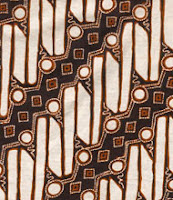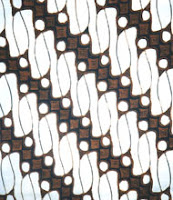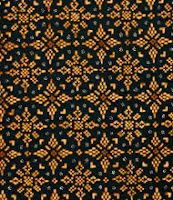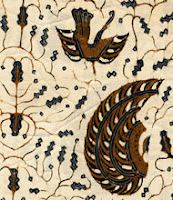Batik patterns are divided into different families of designs, each with hundreds of variations within them. The following gives you a brief introduction to the main design families. You'll see certain designs that belonged to the sacred, forbidden patterns reserved for the royal court. Over time, these particular patterns did enter into common use. Yet to this day, if a person does not belong to the court, they would never wear those patterns inside the keraton, or palace walls.
Ceplok Motifs
The Ceplok family includes a wide range of geometric designs, often based on circular rosettes, stars or other small shapes, forming an overall symmetric pattern on the cloth
Grompol means to gather together. Often worn for wedding ceremonies, the pattern symbolizes the coming together of a harmonious marriage, for children, good luck, and happiness.
Kawung Motifs
The Kawung is one of the oldest designs, and was reserved for the royal family. It represents a cross-section of the aren-palm fruit, and some say the cross in between the four ovals refers to the universal energy source.
While there are many variations, the basic structure is a group of four circles or ovals nearly touching each other, laid out on the cloth in geometric symmetry.
Parang Motifs
Parang Barong
In times past, Parang Barong was a sacred pattern worn only by the king. The motif reminded him to guard himself carefully so he would be a responsible, honest and just ruler.
Parang Rusak
Another of the Parang designs worn by the royal family on state occasions, Parang Rusak symbolizes the human being's internal fight against wickedness by controlling their desires so their wise, noble character would win out.
Lereng
Refers to the diagonal rows of patterns in between the parang motifs. In addition, many patterns are simply rows of narrow diagonal lines filled with a whole array of small patterns. The Udang Liris, again, one of the old patterns reserved for the royal court, is one of the more famous of these motifs.
Udang Liris or light rain symbolizes fertility, the hope for prosperity, determination, to have courage to carry out what's important for the nation and her people.
Nitik Motifs
Nitik Motifs are among the oldest batik patterns and were inspired by woven patola cloths brought by traders from Gujarat, India long ago. The geometric design is created with small dots and dashes imitating the original woven fabric.
Truntum : Worn by parents of a wedding couple the Truntum pattern.
Semen Motifs
Semen, based on the word semi, meaning to sprout or grow, are non-geometric patterns inspired by the natural world. Filled with stylized stems, flowers, leaves, mountains, and animals, this group of designs was highly important for royalty on special occasions, as well as common people in everyday use.
Garuda, the mystical bird-man in Hindu mythology, who carried Vishnu through the heavens, is often portrayed in Semen designs with a single, or pair of wings (Lar) or the wings and tail (Sawat). Often associated with Semen patterns, the wing shape is also found with Parang and Ceplok motifs.
Isen Motifs
Filling patterns called Isen are highly characteristic of Indonesian, especially Javanese, batik. Finely rendered in a wax line, these small designs add a depth and harmonious beauty to the overall cloth.
Now that you have a glimpse into the world of traditional Yogyakarta batik, discover the batik process in creating these intricate cloths, here.
If you're already familiar with the process, learn about making batik in our workshops, customized just for you, here.
















